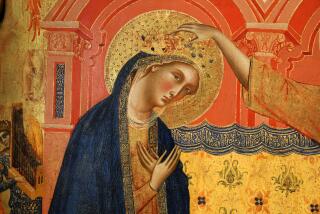Sicilian Godfather’s Activity Is Subject to Frame-up
- Share via
They’re making Luciano Liggio offers he can’t refuse. Liggio, the painter, has 55 of his artworks exhibited at a Palermo, Italy, gallery, and on the first day over the weekend, 40 had been sold. The paintings depict scenes from the Sicilian hill town of Corleone, and one buyer reportedly paid $8,500 for a canvas. Actually, Liggio has little else to do these days but paint. The man who is called the real-life “Godfather” of Corleone, a name made famous by author Mario Puzo in the book and movie called “The Godfather,” is serving a life sentence at Ucciardone, Palermo’s fortress prison, for various Mafia crimes. The Mafioso was refused permission by a judge to attend his art show, and it was not clear why the Justice Ministry did not allow his recent paintings to be shown. “It’s a pity that the most beautiful works are in his cell . . . . “ Salvatore Traina, Liggio’s lawyer, said.
--Monna Loughridge’s friends thought she had too much to drink this past New Year’s Eve. Seated in a coffee shop in Columbus, Ohio, in the wee small hours of the morning after, Loughridge, 36, glanced at a man sitting near her. The glance turned to a stare, and before she could say “Happy New Year,” she cried tears of joy. Monna had found a father she had not seen in 12 years. “I just started crying, and then I think I said, ‘Happy New Year. I’m your daughter,’ ” she said. “I didn’t even know if he was alive. If this isn’t fate, I don’t know what is.” Jack Willis, 59, said he had gone to the restaurant because he couldn’t sleep. “I sure lucked out,” he said. “I couldn’t have asked for anything better for the new year.” Monna lost touch with her father after her parents divorced and her mother remarried a serviceman. But for now, father and daughter plan to keep in touch.
--Chances are they would not make your mouth water. But these meat and vegetable recipes would almost certainly catch your fancy. The 25 recipes, inscribed on three clay tablets, dating from 1700 BC, are from Mesopotamia, the “cradle of civilization,” and they come our way because Yale University recently celebrated the 75th anniversary of its 40,000-item Babylonian collection in New Haven, Conn. William W. Hallo, curator of the Yale Babylonian Collection, said that the recipes are probably the oldest cookbooks in existence. “They are recipes and as such practically a unique genre that one simply has not encountered before in cuneiform literature,” said Hallo, who is a professor of Assyriology and Babylonian literature. Some of the meats include stag, gazelle, kid, lamb, mutton, squab and a bird called tarru.
More to Read
Sign up for Essential California
The most important California stories and recommendations in your inbox every morning.
You may occasionally receive promotional content from the Los Angeles Times.













